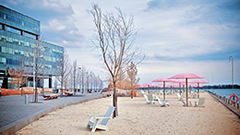The question of how to develop Toronto’s waterfront has dogged city politicians for decades. Mayor Rob Ford and his brother, councillor Doug Ford, weighed in with their own proposal earlier this year, but had to back down after a storm of criticism from concerned residents. U of T Magazine editor Scott Anderson asked Susannah Bunce, a UTSC geography professor, about the principles behind good waterfront development.
Which cities should we be using as models for waterfront development?
Chicago has been especially good at attracting architecturally unique buildings, such as Frank Gehry’s concert theatre in Millennium Park. Certain parts of London’s Riverside development, such as the South Bank area, have successfully regenerated former industrial spaces into cafés, galleries and residential uses. From a visitor’s perspective and based on aesthetics, I think that Chicago’s Millennium Park and Copenhagen’s Canalside are very attractive and engaged places.
How does one judge whether a waterfront is “successful”?
Attractive buildings, mixed-use spaces and large parks with interesting design elements, are all considered to be hallmarks of good redevelopment. Liverpool’s Albert Dock, for example, is a strong example of how to develop old port buildings into mixed-use spaces, with tourist attractions, such as the Merseyside Maritime Museum, which represent the city’s historical role as a major port, and the Beatles Museum, a nod to the city’s modern cultural influence. Because most de-industrializing waterfront spaces are uninhabited, city residents often don’t get much say into plans. Successful development gives local citizens an ongoing role in shaping and using waterfront spaces in socially and environmentally just ways. For example, affordable housing in mixed-use development is important to create a socially inclusive waterfront.
How have our views about waterfront development – or community development in general – changed in the last few decades?
The 1980s marked a general shift away from industrialized waterfronts to post-industrial development, with mixed-use residential and commercial spaces. There are still exceptions to that, however, with examples of both industrial and post-industrial uses in major port cities. In Toronto, the Toronto Economic Development Corporation was formed in 1985 in order to attract industry back to the Port Lands area. At the same time there was also a public vision for a post-industrial waterfront. There has been more focus on public involvement in planning and community processes, often because of legislative necessity.
What most often gets in the way of successful development?
Politicians and planners who don’t take architectural considerations or “good design” into consideration are often criticized; waterfront developments can frequently appear generic. Lengthy public consultations are blamed for slow development. But in the long term, development plans that do not take into account a diverse public end up creating exclusive and inequitable waterfront spaces.
What have been Toronto’s biggest mistakes with respect to its waterfront?
The actors involved in Toronto’s waterfront development have placed a lot of emphasis on attracting and securing private sector investment. Waterfront Toronto’s comprehensive redevelopment plan relies on augmenting existing municipal, provincial and federal funding by selling public land to the private sector. However, I don’t think there is anything wrong with slow and well-planned publicly funded development, even if it’s a small area of the waterfront. In my opinion, maintaining publicly owned waterfront land is key to fostering sustainable and inclusive planning and development.
What do think of Waterfront Toronto’s plan?
The positive element of Waterfront Toronto’s plan is the emphasis on sustainability and implementing LEED ratings. The agency seems to be committed to public space development and ecological restoration, such as naturalizing the mouth of the Don River. But the plan relies too much on private sector investment and the sale of public lands to private developers.
Is there anything inherently wrong with wanting to put a shopping centre or a tourist attraction in the Port Lands?
These types of decisions should be left to the people who live near the Port Lands – the residents, local businesses and community agencies of South Riverdale. A large mall such as the one that Doug Ford proposed might well draw business away from nearby neighbourhoods. On the other hand, it’s possible that nobody would visit it because there are other malls closer to where they live. I question the relevance of tourist attractions for the everyday lives of people in Toronto; they are also often expensive to visit.
The Fords have criticized the slow pace of development. What can be done to speed things up without casting aside the whole plan?
It might be possible to speed up plans for the public land, but with the current downturn in real estate development and global economic concerns, Waterfront Toronto’s reliance on private-sector investment makes it more difficult to create quick mixed-use development with the specifications that it has formulated – such as adherence to LEED ratings on all new buildings.
Should a 30-year plan not be subject to change as new ideas emerge or conditions change?
Waterfront Toronto’s vision has changed since its inception. Initial discussions pointed to the Port Lands as one of the first sites for redevelopment and then, due to environmental remediation challenges and jurisdictional constraints, it became the third area for redevelopment following the West Don Lands and East Bayfront districts. Plans usually change based on market fluctuations and changes in vision, so it is possible that Waterfront Toronto’s plans will change again until their mandate for redevelopment is complete.
A shorter version of this Q&A appeared in the Winter 2012 print edition of U of T Magazine






